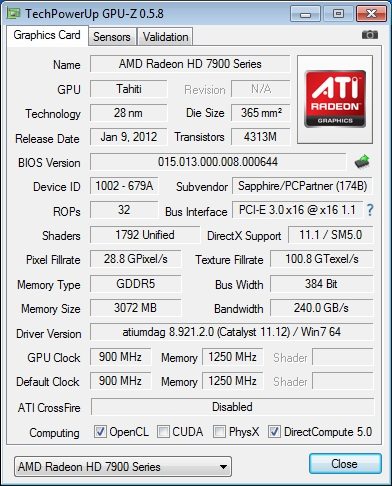Sapphire Radeon HD 7950 OC 3GB Graphics Card Review
Chris Hadley / 13 years ago
Our first glance at the card shows us another factory design heatsink and fan design utilising heatpipe technology to keep everything cool. Covering this is a unique black plastic cover that allows for a free airflow in and through the card and heatsink.
On the top of the card we find the two PCIe power connections, which as we know by now is more than sufficient to provide the 7950 with its power needs.
On the other end of the card we see the pair of CrossFire connections for multi-GPU CrossFireX setups. Nestled just to the side of the right hand crossfire tab there is a switch for alternating between the two onboard BIOS that was found on the 7950 reference cards. The default BIOS has the card clocked at 900MHz core and 1250MHz(5Ghz effective) on the memory at stock voltages. Switching the card to the secondary BIOS retains the factory overclock speeds but ups the core voltages to assist in overclocking in Sapphires TriXX Overclocking utility.
The rear bracket of Sapphires 7950 OC follows a complete factory design and as such we find a dual-link DVI port, HDMI and two mini DisplayPort connections.
Taking the cooler away from the card we can immediately see that it comes as two separate parts. The black plate at the bottom of the image is used to cool all of the GDDR5 memory and other components, connecting to the expansion bracket at the rear to transfer the heat away from the card itself. The remainder and the bulk of the cooler sits on top of the GPU core and works on a heat pipe design to transfer heat away to the heatsink that covers the length of the card. On the top of this there are two ultra quiet fans that push air in and around the cooler.
Underneath the cooler we see the five all copper heat pipes that connect into a pure copper base for the best thermal transfer possible. On the underside of the memory sink we can see all the thermal transfer pads used for various components across the board. The aluminium plate also doubles up as a supporting bracket reducing any flex in the card that may occur post installation.
Laid bare, we see the reference layout of the 7950 which we are all now becoming very familiar with Sapphire have laid this all onto their own Sapphire coloured PCB.
Being an overclocked edition of the 7950, we see that the core clock speed has been raised from 800MHz to 900MHz however the memory speed has been left at the factory 1250Mhz. As we have heard, there is supposedly a lot of headroom for overclocking on the 7950 and when set into the secondary BIOS which has raised voltages, there should be more than enough space to raise both of these to 7970 territory.



























